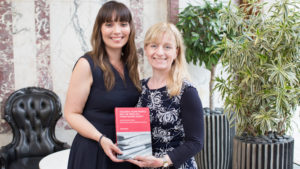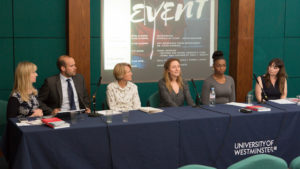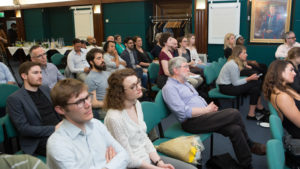What are children and young people’s rights in the media in a transitioning society like Northern Ireland? Why do editors and journalists here still struggle to come to grips with replacing news coverage through the lens of the conflict? What good can generalisations of ‘anti-social behaviour’ and ‘hanging around on street corners’ do for the self-esteem of the generation hailed as our new hope at the time of the Good Friday Agreement?
These are just some of the questions which Dr Faith Gordon seeks to answer in her book launched in London last week: ‘Children, Young People and the Press in a Transitioning Society: Representations, Reactions and Criminalisation’.
Faith’s academic journey
Originally from Annaclone, rural County Down, Faith studied at Queen’s University in Belfast before going on to lecture in Criminology at the University of Westminster where she’s also Director of the interdisciplinary Youth Justice Network. In September she’ll begin an exciting new position as Lecturer in Criminology at Monash University in Melbourne, Australia, and continue to research and write on the areas of children’s rights, youth justice, victimology and the media.

Faith’s work is the first to explore this topic of children, young people and the media, in the context of a post-conflict society. It has been utilised by the children’s sector when reporting to the United Nations Committee on the Rights of the Child, has been referred to by the UN Committee, particularly in relation to research on the PSNI’s publication of children’s images and continues to be utilised by legal practitioners in Northern Ireland for judicial reviews relating to these issues.
Over ten years this work has been with her now. At undergraduate level, primary research clearly flagged up the negative impact of the print media’s representation of children and the negative perception that had been generated around children’s organisations work and, more broadly, of children’s rights. Many of those she interviewed as part of her dissertation then, she says, “expressed great concern for individual children they felt had been unfairly targeted by the media… which grouped all children and young people as ‘anti-social’, ‘bad’ and their behaviour as ‘troublesome’, ‘criminal’ and in many cases ‘violent’.”
When directly challenging the media and politicians on their use of language, those working in the children’s and youth sector organisations recounted how typical responses dismissed their concerns. As a sector, they called for the need for an evidence-base, which they could draw upon to lobby politicians and call on the media to be much more ethical and responsible in their use of language and choice of imagery, when reporting on children and young people, particularly those ‘in conflict with the law’. Faith fondly recalls her studies and employment at Queen’s University Belfast as a Post-Doctoral Researcher, this is when she learned first-hand the significant impact of the children’s rights sector.

Why is this research so important?
Twenty years after the Good Friday Agreement it’s an important time to examine how the media narrative has evolved in Northern Ireland. It’s also time to explore, more generally, media regulatory bodies, arrangements and what impact the suggested reforms might have. Just last week the government announced it will appoint an independent reviewer for press standards, which it insists is not a Leveson-style inquiry for Northern Ireland. Faith has long argued that children should be a special case when it comes to media regulation.
This is an original study. Whilst for decades the academic literature on the media in Northern Ireland has mainly focused on the portrayal of the Conflict, with some exceptions, Faith’s work delves into the impact of change and transition. It compasses content analysis from six months of print media and a case study on the representation of youth involvement in ‘sectarian’ rioting, and analyses interviews with editors, journalists, politicians, policy makers and a spokesperson for the Police Service of Northern Ireland.
The research also features the voices of children and young people who have experienced first-hand the negative consequences of the media’s representations of youth suicide, media intrusion, ‘naming and shaming’ and punishment beatings, shootings and exiling from the community.

And what are the implications of this labelling of young people? For Faith, this research confirms they are convenient scapegoats – where their negative reputation diverts attention from the structural and institutional issues that are inevitable in a post-conflict society.
Children’s rights are consistently being breached and this needs to be recognised and challenged. She has argued, for example, that future students of journalism are specifically trained in children’s rights. The contributions of children and young people in the media should also be meaningful, not tokenistic. The mainstream media’s often unwillingness to provide ‘alternative’ voices, she says, ultimately impacts on media content.
These are just some highlights of a timely study given the wider political and media landscape – compiled after Lord Justice Leveson’s public inquiry findings into the culture, practices and ethics of the British press following the News International phone hacking scandal.
The original version of this article was posted on 17 May. Faith launched ‘Children, Young People and the Press in a Transitioning Society: Representations, Reactions and Criminalisation’, published by Palgrave, at the University of Westminster, on 24 May. More information can be found here.
Also published on Medium.
